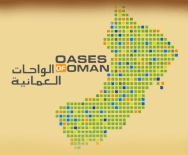Work package: Archaeological investigations in respect to the origin and development of oasis settlements in Oman
Contact Person: Dr. Jutta Häser, German Protestant Institute of Archaeology, Amman
Scientific staff and PhD students: Dr. Jutta Häser, Dr. Jürgen Schreiber, Nicola Schreiber, M.A., Frank Voigt, M.A.
Objectives: The research is focused on processes of transformation throughout history, regarding the architecture and material culture, the economy and ecology of the oasis settlements in a regional and interdisciplinary approach. The aim of the archaeological study is the investigation of the settlement in respect to their establishment and development as well as their ecological setting.
Study locations:
Archaeological survey at Tiwi
The modern village of Tiwi is located on the coast some 120 km southeast of Musqat and 40 km northwest of Sūr. Archaeological exploration of this coastal strip started in the late 1970s and several surveys were done since then. Most sites recorded during these surveys in the area of Tiwi were shell middens or flint scatters dating to the 5th/4th millennium BC or sites of the Islamic period. As all these surveys concentrated on sites located immediately at the coast or just beside the modern road, in 2002 a survey was conducted, incorporating also the hinterland of Tiwi (i. e. Wadi Tiwi and the area between the coast and the mountains). In the course of this survey many sites of the Islamic periods as well as a Late Iron Age hill fort / settlement and the vast adjacent cemetery were discovered.
The starting point of the work was in Wadi Tiwi. Beginning at the coast, this wadi stretches into the Hajar mountains, but the gravel road ends after 12 km at the oasis of Mibām, from where it is barely possible to cross the mountains by foot. Since Wadi Tiwi has a perennial water flow, it was expected to find relics of prehistoric occupation there. When the area has been examined, it turned out that the existing villages and oases were not established before the Early Islamic period, probably in the 9th or 10th century AD, and were continuously inhabited until today. Only three prehistoric potsherds of the Late Iron Age were found in Wadi Tiwi, halfway between the coast and Mibām. Thus, it must be assumed that the wadi was used for agricultural purposes in this period, but was not really permanently inhabited in prehistoric times.
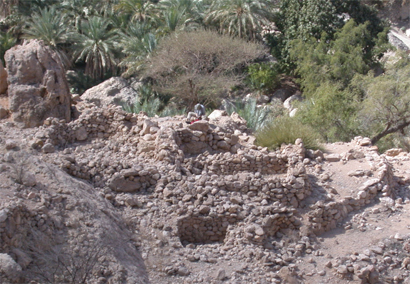
Settlement ruins in Wadi Tiwi (TW07), the findspot of the prehistoric sherds © 2002 DAI Orient-Abteilung Berlin
In the course of the work at the coast between Tiwi and Shāb, the picture changed dramatically. More than 1200 archaeological remains from the late 4th - early 3rd millennium B.C. until the Late Islamic period have been discovered.
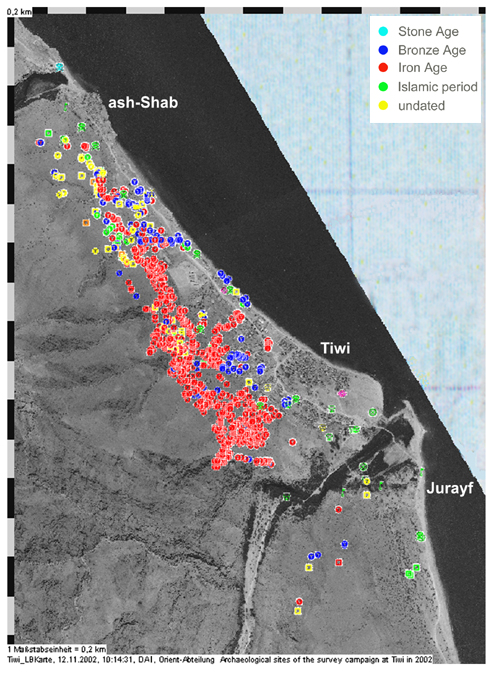
Plan of distribution of archaeological sites at Tiwi © 2002 DAI Orient-Abteilung Berlin
The oldest datable remains are about 130 Hafit tombs (late 4th or early 3rd millennium B.C.). They are situated at the entrance of Wadi Tiwi, at the edges of some smaller wadis, which are running from the terraces above Tiwi, as well as along the cliffs of the coast.
In some of these Hafit tombs finds of secondary burials of the Umm an-Nar period (3rd millennium B.C.), the Wadi Suq period (2nd millennium B.C.) and the early Iron Age (1200-600 B.C.) have been discovered. These finds include pottery sherds of black painted gray and red ware (Umm an-Nar period), fragments of softstone vessels and a softstone lid (Wadi Suq period, early Iron Age period), two bronze arrow heads (early Iron Age) and the first Iron Age stamp seal in Oman (Häser – Schreiber 2003). However, only these secondary burials give a hint at the occupation of that area in these periods (except some pottery sherds of early Iron Age date in settlement context, see below).

Pyramidal seal with ostrich depiction in finding context in the chamber of tomb TW0267 © 2002 DAI Orient-Abteilung Berlin
An intensive sedentary use of the area between /īwī and ash-Shāb is recognizable for the late Iron Age (300 B.C.-900 A.D.). A cemetery with about 950 tombs of that period has been discovered, which is situated from the settlement area of Tiwi and ash-Shāb to the natural terrace above these settlements. It stretches from Tiwi to ash-Shāb; however, it is more densely occupied at Tiwi than at ash-Shāb. The tombs are built overground and of a simple layout with some variations. To show the variety of these tombs, about 100 of them were photographed. All tombs were registered with a Global Positioning System. Since the tomb chambers are not very large, it has to be assumed that they were occupied by one or maybe two persons. However, the state of preservation of the bones is very bad and only excavations could clarify this situation. Pottery sherds of late Iron Age were found sometimes inside the grave chambers, however in most cases outside the tombs, since all of them were opened, probably already in ancient times. Additionally, various kinds of mollusces and fishbones were found. Only outside two tombs one carnelian and one alabaster bead respectively were found. Also in this case, only excavations could show if there are more finds left in the tombs or if the burials were equipped with pottery, mollusces and fishbones only.
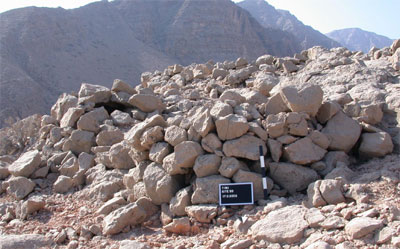
Two late Iron Age tombs on the terrace north of Wadi Tiwi and west of Tiwi. Tomb TW0028 is seen in the background and tomb TW0033 in the foreground © 2002 DAI Orient-Abteilung Berlin
However, not only this large cemetery has been discovered, but also the settlement of the same date. It is situated on the southeastern side of Wadi /īwī above the settlement of Tiwi Jurayf. It covers an area from the clearly visible Islamic tower on the north to the plateau on the south. An architectural plan and a detailed description of the architectural remains have been made. Based on these studies, it has to be assumed, that the oldest part of the settlement is situated at the northwestern slope of the area. There are houses and terraces recognizable that are built with very large stones in a special building technique. These differ slightly from the later architectural remains. Additionally, the distribution of the pottery sherds gives a hint at the oldest occupation in the northwest.
Presumably, this is not the oldest occupational phase, since we found also some early Iron Age pottery sherds. However, the amount of pottery sherds of this period is not very high, therefore, the occupation could not be very intensive.
The other house and terrace remains are also built with stones, but mostly with smaller ones. Presumably, also Iron Age walls were re-used in later times. The second intensive occupational phase can be dated to the middle Islamic period based on the pottery sherds. However, also some early Islamic sherds were found, so that the occupation can be assumed as continuously with various intensification phases. During the middle Islamic period a citadel was constructed just below the tower, though this tower is clearly of late Islamic date and no older foundations were found. In the late Islamic period the settlement was only used peripheral. Some badly built walls were added to existing walls and terraces probably as shelters or stables. The only fundamental addition was the tower, mentioned above. Only few sherds of late Islamic date were distributed in the area.
In conclusion we can assume an occupation of that settlement area from the early Iron Age to the late Islamic period with two main occupational phases in the late Iron Age and the middle Islamic period.
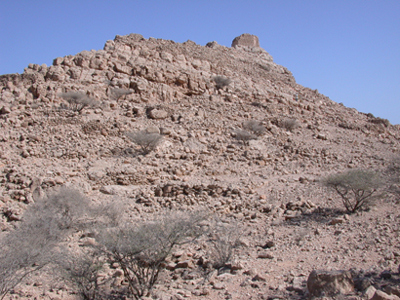
Settlement ruin on the natural terrace above Tiwi Jurayf (TW0002). View from southeast on the northwestern slope with the probably oldest architectural remains of the settlements. The hill is crowned with a late Islamic tower © 2002 DAI Orient-Abteilung Berlin
The early and middle Islamic period is represented at the destroyed settlement at Tiwi Jurayf (TW0015). It is situated at the coast and stretches to the foot of the mountain on the southeastern side of Wadi Tiwi. It is this settlement, that was mentioned by Ibn Ba77ū7a in 1331 AD. It was destroyed during the Portuguese invasion in 1507 AD.
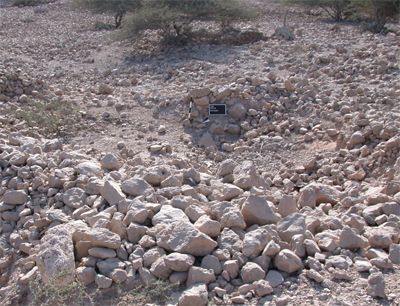
Very dilapidated settlement ruins at the early and middle Islamic site of Tiwi Jurayf (TW0015) © 2002 DAI Orient-Abteilung Berlin
Only houses at the foot of the mountain were re-built in later times. In contrast, the coastal part of this settlement was never re-occupied. Some walls are still visible on the surface to give insight in the plan of the site. The pottery sherds give a date for the occupation from the 9th to the 16th century AD. Only few sherds are of late Islamic date. The early and middle Islamic pottery assemblage shows a broad variety of different imports from Persia as well as China and links Tiwi with the Indian Ocean trade. Since the site is very import for the understanding of the trade connections of Oman with the Islamic world as well as for the relations between coastal and inland sites at that period, it would be worth to protect this area, since it is very much endangered by modern building activities.
A large Islamic cemetery with approximately 3000 to 4000 graves is situated southeast of Tiwi Jurayf. A lot of middle Islamic pottery sherds were found on the tombs. It is probable, that this cemetery was used by the inhabitants of the middle Islamic town of Tiwi Jurayf.
After the destruction of the settlement at Tiwi Jurayf in the early 16th century AD the main building activities seem to shift to the north side of Wadi Tiwi, where the old town and also the modern town of Tiwi is situated. Several large Islamic cemeteries are located also on this site of the wadi.
Support
The archaeological project was financed by the German Institute of Archaeology, the Sultan Qaboos University Muscat and the German Research Foundation.
Publications
 |
Haeser, J. 2003. Tiwi und Wadi Tiwi (Oman), Jahresbericht des Deutschen Archäologischen Instituts 2002. Archäologischer Anzeiger 2003/2, 252-253.
|
| |
Haeser, J. 2007. „Sie ist eine der hübschesten Städte und eine der bewundernswertesten an Schönheit ...“: Interdisziplinäre Forschungen in der Küstenoase Tiwi (Sultanat Oman). Antike Welt 2007/4.
|
 |
Haeser, J. & Schreiber, J. 2003. Ein eisenzeitliches Pyramidensiegel aus Oman. Baghdader Mitteilungen 34, 205-219.
|
| |
Ibrahim, M. & ElMahi, A.T. 2000. A Survey between Quriyat and Sur in the Sultante of Oman (1997). Proceedings of the Seminar for Arabian Studies 30, 119-136.
|
 |
Korn, L., Haeser, J., Schreiber, J., Gangler, A., Nagieb, M., Siebert, S. & Buerkert, A. 2004. Tiwi, Ash Shab and Wadi Tiwi: the development of an oasis on the north-eastern coast of Oman. Journal of Oman Studies 13, 57-90.
|
 |
Schreiber, J. & Haeser, J. 2004. Archaeological survey at Tiwi and its hinterland (Central Oman). Proceedings of the Seminar for Arabian Studies 34, 319-329.
|
| |
Tosi, M. & Usai, D. 2003. Preliminary Report on the Excavations at Wādī Shab, Area 1, Sultanate of Oman. Arabian Archaeology and Epigraphy 14, 8-23.
|
| |
Usai, D. 2006. A fourth-millennium BC Oman site and its context. Proceedings of the Seminar for Arabian Studies 36. |
© Jutta Häser
|
